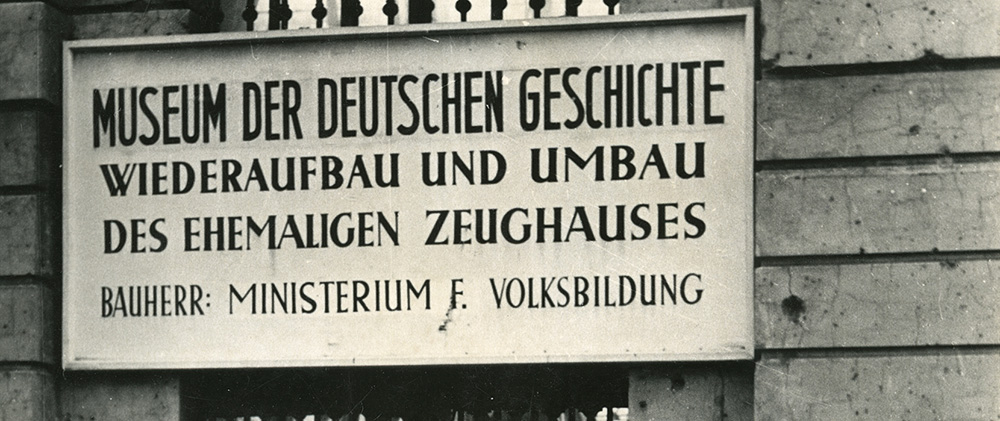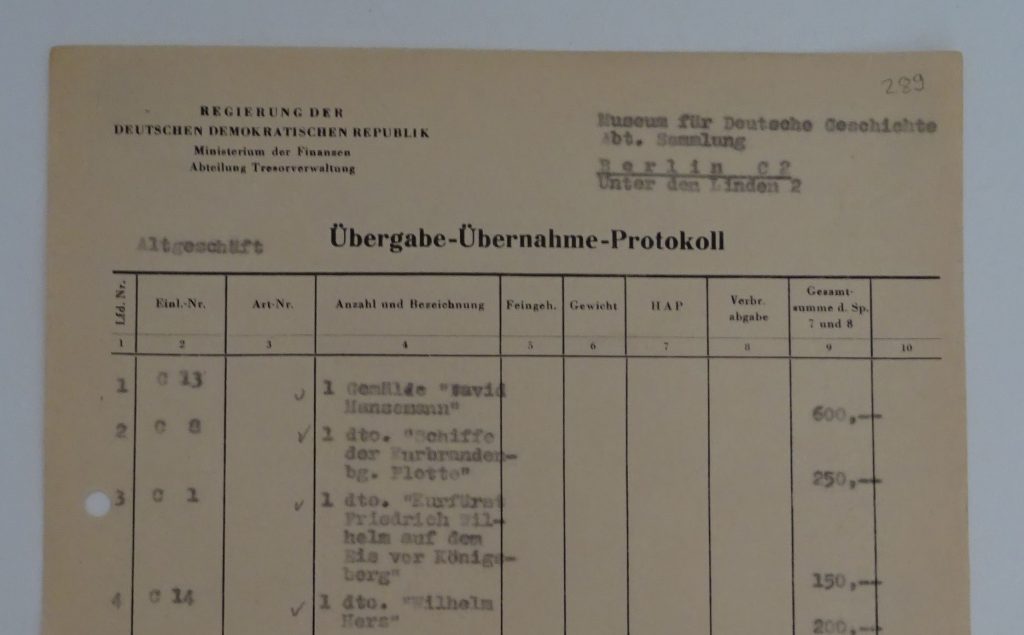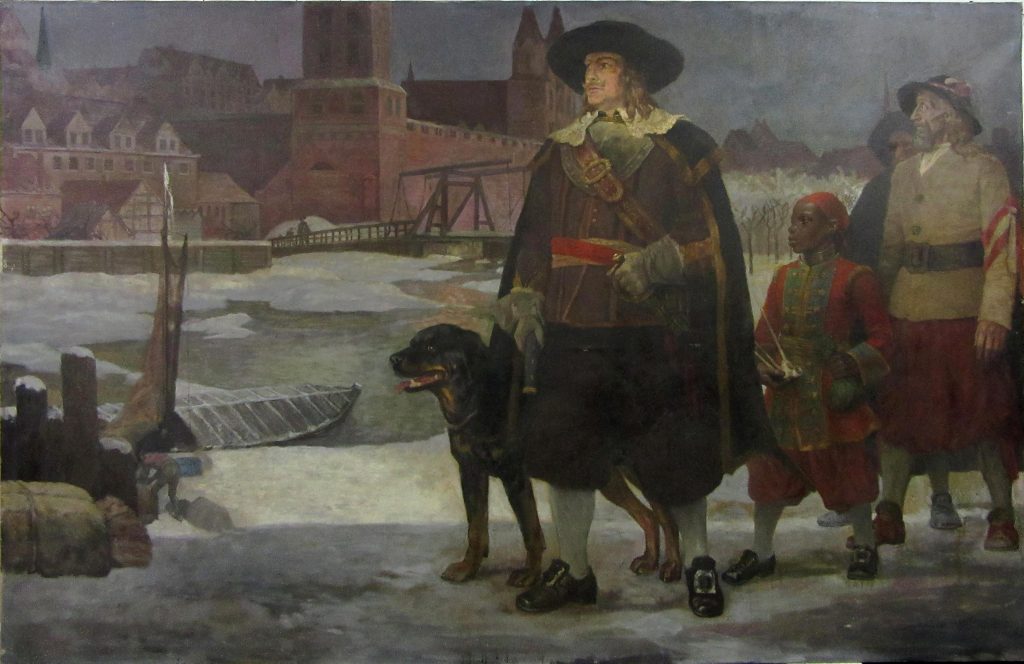
With combined forces towards a central history museum of the GDR
Janine Kersten | 17 May 2023
The Museum für Deutsche Geschichte (MfDG) was officially founded on 18/19 January 1952 in East Berlin. Time was pressing, because the first permanent exhibition was to open only six months later. Janine Kersten, provenance researcher at the DHM, sketches the great effort the museum undertook in its founding years to build up its collection as quickly as possible. She pays particular attention to the objects that came to the collection from the Department of Depository Management (Tresorverwaltung) in the Finance Ministry of the GDR.
As the Museum für Deutsche Geschichte was being built up, it worked as quickly as possible to acquire objects suited for the exhibition. When it was founded, the museum had at its disposal above all the collection of the old Berlin Zeughaus, which consisted almost exclusively of militaria, such as historical weapons, uniforms and medals, as well as smaller bundles of different objects.
A resolution of the Central Committee (ZK) of the Socialist Unity Party (SED) in December 1951 determined that the MfDG should be supported by various state institutions in the build-up of its collection.[1] Called upon for support were, among others, the State Secretariat for Higher Education, the State Commission for Art Affairs as well as such mass organisations as the Free German Youth and the Cultural Association. In addition, various other state institutions supplied the museum with objects: the SED, the Department of Depository Management in the Finance Ministry, the Interior Ministry or Ministry for State Security, executive organs such as the councils of the communities, cities, districts and regions, the departments of the German People’s Police, and the customs offices. Other folk and history museums throughout East Germany were also expected to contribute objects to the MfDG.[2]
The museum was not only a passive recipient of museum goods, but actively contacted institutions to find objects and undertook “scientific expeditions for the study and acquisition of documents and materials.” [3] Radio and newspaper appeals also called for the active support of the population.[4]
The museum was looking in particular for valuable original objects such as furniture, paintings,[5] graphic prints, militaria (e.g., medals, historical weapons and parts of uniforms), documents (e.g., historical certificates, flyers and posters), but also for publications from countries in the West[6] as well as objects that were “seemingly without considerable artistic or material worth, but which characterise the social epoch from which they come.” [7]

For our work we must mobilise the mayors in the countryside, etc. They know where valuable original objects (furniture, pictures, etc.) can be found. In this way such important pieces can be supplied to the museum. In every region there is a commission for local history and conservation that will be willing to actively contribute.
Comment by Hermann Weidhaas, member of the Scientific Council of the MfDG, protocol of the conference
of the Scientific Council of the MfDG, 1 March 1952, DHM-HArch, MfDG/41, Bl. 28. © DHM
In the framework of a two-year basic research project of the Deutsches Historisches Museum that was carried out in cooperation with the German Centre for Lost Cultural Property, Janine Kersten conducted research on the Department of Depository Management in the Finance Ministry (MdF) of the GDR and the objects it transferred to the MfDG. Altogether 1,380 individual objects came from this department to the museum. They included paintings, books, historical documents, glasses, graphic prints, porcelain, coins, commercial papers, and jewellery.
The Depository Management was founded in March 1953 upon resolution of the ZK as an independent department of the MdF.[8] In a strictly confidential communication, the department is described as the “central office for the disposal of all objects of value and precious items sequestered and confiscated in the GDR and the democratic sector of Greater Berlin.” [9] The providers of these objects were individual departments of the GDR, such as the administrative offices for state property, the People’s Police, public prosecutors, and the office for customs and control of the traffic of goods as well as the offices in charge of impounding, such as court bailiffs.
The list of the “sequestering and confiscating” providers includes many institutions that can be designated as critical provenances for GDR provenance research, in other words, it means that the objects delivered to the Depository Management also included expropriations in connection with the land reform (“castle recoveries”) in the Soviet Occupation Zone or which came from people who had emigrated from the GDR or “fled the republic”.
In the early 1950s, the Depository Management, on behalf of the ZK, was also in charge of the “disposal” of the objects that had been placed in safekeeping in the treasuries of the old Berlin banks, such as the former Reichsbank or the Deutsche Bank. This was carried out in part without any legal basis and was therefore strictly confidential.
The MfDG effected the first purchases from the Depository Management for the collection in 1954. The acquisition protocols list primarily Meissner porcelain, but also paintings and graphic prints. A further purchase was made in September 1955 in the form of glassware. These objects came verifiably from the safes of the closed-down former Berlin banks.


However, the MfDG not only bought museum objects from the Depository Management, but also received objects for free. A bundle of more than 1,100 historical documents had already been given to the museum in 1953. In the MfDG’s inventory book, the State Museums of Berlin (SMB) are named as a deliverer. However, research has shown that these objects originally came from the Depository Management. The SMB only acted as an interim storage place before the decision was made to give the manuscripts to the MfDG.[10] Two years later, the museum again received a transfer in the form of 16 map engravings, books and various weapons.[11] The circumstances under which the objects came to the possession of the Depository Management were of minor importance to the MfDG – the rapid expansion of the collection was paramount to the museum. However, since the Depository Management verifiably played a central role in the “disposal” of sequestered and confiscated cultural goods, the objects of this provenance are most thoroughly researched by the provenance researchers of the DHM. The basic research project on the Depository Management continues to run until October 2023. You can find an initial view of the current state of the research in Janine Kersten’s intermediate report here.
[1] Appendix 15 of the protocol No. 125 of the session of the ZK of the SED from 13 Dec. 1951, BArch DY 30/55926, Bl. 118ff.
[2] Ibid.
[3] Draft of the statutes of the Museum für Deutsche Geschichte from 25 Feb. 1952, BArch DR3/4039, Bl. 29f.
[4] Cf. e.g., DHM-HArch, MfDG/Rot/vorl. 538; MfDG/Rot/vorl. 925 und MfDG/Abt. Slg.-Fundus/vorl. 254.1.
[5] Protocol of the conference of the Scientific Council of the MfDG, 1 March 1952, DHM-HArch, MfDG/41, Bl. 28.
[6] Ibid.
[7] Cf. copy of a memorandum from Hermann Weidhaas to the Thuringian regional commission of the friends of the homeland and nature, March 1952, DHM-HArch, MfDG/458.1, Bl. 122f.
[8] Cf. internal communication of the Department of Depository Management to the Deputy Minister of Finance, Martin Schmidt, 6 Dec. 1955, BArch DN 1/3439.
[9] Ibid.
[10] Cf. Kachel, Doris: Repräsentative Studie zu den Übergaben staatlicher Institutionen und Organisationen an das Museum für Deutsche Geschichte der DDR, Berlin 2020, p. 32.
[11] Cf. DHM-HArch, MfDG/Abt. Slg.-Fundus/vorl. 6.2. The pieces were labelled as “bad” by the MfDG and designated for storage or to be passed on.
 © Thomas Bruns |
Janine KerstenJanine Kersten a member of the research staff at the Deutsches Historisches Museum. |